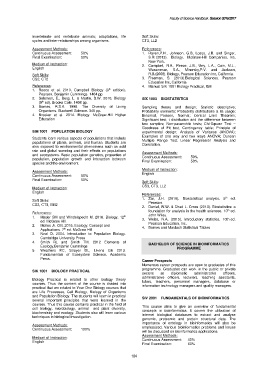Page 109 - handbook 20162017
P. 109
Faculty of Science Handbook, Session 2016/2017
invertebrate and vertebrate animals; adaptations, life Soft Skills:
cycles and inter-relationships among organisms. CT3, LL2
Assessment Methods: References:
Continuous Assessment: 50% 1. Raven,P.H., Johnson, G.B, Losos, J.B. and Singer,
Final Examination: 50% S.R (2013). Biology, McGraw-Hill Companies, Inc,
New York.
Medium of Instruction: 2. Campbell, N.A., Reece, J.B., Urry, L.A., Cain, M.L.,
English Wasserman, S.A., Minorsky,P.V. and Jackson,
Soft Skills: R.B.(2008). Biology, Pearson Education Inc, California.
CS2, CT2 3. Freeman, S. (2013).Biological Sciences. Pearson
Education Inc, California
References: 4. Manual SIK 1001 Biology Practical, ISB
1. Reece et al. 2010. Campbell Biology (9 th edition).
Pearson, Benjamin Cummings. 1464 pp.
2. Solomon, E., Berg, L. & Martin, D.W. 2010. Biology SIX 1003 BIOSTATISTICS
th
(9 ed). Brooks Cole. 1408 pp.
3. Barnes, R.S.K. 1998. The Diversity of Living Sampling theory and design; Statistic descriptive;
Organisms. Blackwell Science. 345 pp. Probability elements; Probability distributions & its usage;
4. Brooker et al. 2014. Biology. McGraw-Hill Higher Binomial, Poisson, Normal; Central Limit Theorem;
Education Significant test; t distribution and the difference between
two samples; Non-parametric tests; Chi-Square Test –
Goodness of Fit test, Contingency table; Principle of
SIH 1001 POPULATION BIOLOGY experimental design; Analysis of Variance (ANOVA);
Examples of one way and two ways ANOVA; Duncan
Students learn various aspects of populations that include Multiple Range Test; Linear Regression Analysis and
populations of plants, animals, and human. Students are
also exposed to environmental phenomena such as acid Correlation.
rain and global warming and their effects on populations Assessment Methods:
and ecosystems. Basic population genetics, properties of Continuous Assessment: 50%
population, population growth and interaction between
species and the environment. Final Examination: 50%
Assessment Methods: Medium of Instruction:
English
Continuous Assessment: 50%
Final Examination: 50%
Soft Skills:
Medium of Instruction: CS3, CT3, LL2
English References:
1. Zar, J.H. (2010). Biostatistical analysis. 5 th ed.
Soft Skills: Pearson.
CS3, CT3, EM2
2. Daniel, W.W. & Chad L. Cross (2013). Biostatistics: a
th
foundation for analysis in the health sciences. 10 ed.
References: John Wiley.
1. Mader SM and Windelspecht M. 2016. Biology. 12 th 3. Weiss, N.A. (2015). Introductory statistics. 10th ed.
ed. McGraw Hill.
2. Molles Jr. CM. 2016. Ecology: Concept and Pearson Education, Inc.
th
Applications. 7 ed. McGraw Hill 4. Barnes and Murdoch Statistical Tables
3. Neal D. 2004. Introduction to Population Biology.
Cambridge University Press
4. Smith RL and Smith TM. 2012 Elements of BACHELOR OF SCIENCE IN BIOINFORMATICS
Ecology.Benjamin Cummings
5. Weathers KC, Strayer DL, Likens GE 2013. PROGRAMME
Fundamentals of Ecosystem Science. Academic
Press. Career Prospects
Numerous career prospects are open to graduates of this
SIK 1001 BIOLOGY PRACTICAL programme. Graduates can work in the public or private
sectors as diplomatic administrative officers,
administrative officers, lecturers, teaching assistants,
Biology Practical is related to other biology theory tutors, teachers, personnel managers, database or
courses. Thus the content of the course is divided into information technology managers and quality managers.
practical that are related to Year One Biology courses that
are Life Processes, Cell Biology, Biology of Organisms
and Population Biology. The students will learn in practical SIV 2001 FUNDAMENTALS OF BIOINFORMATICS
several important principles that were learned in the
courses. Thus this course contains practical in the field of
cell biology, microbiology, animal and plant diversity, This course aims to give an overview of fundamental
biochemistry and ecology. Students also will learn various concepts in bioinformatics. It covers the utilization of
techniques in biological investigation. internet biological databases to extract and analyse
genomic, proteomic and protein structural data. The
importance of ontology in bioinformatics will also be
Assessment Methods: emphasized. Various bioinformatics problems and issues
Continuous Assessment: 100%
will be discussed on bioinformatics applications.
Assessment Methods:
Medium of Instruction: Continuous Assessment: 40%
English Final Examination: 60%
104

